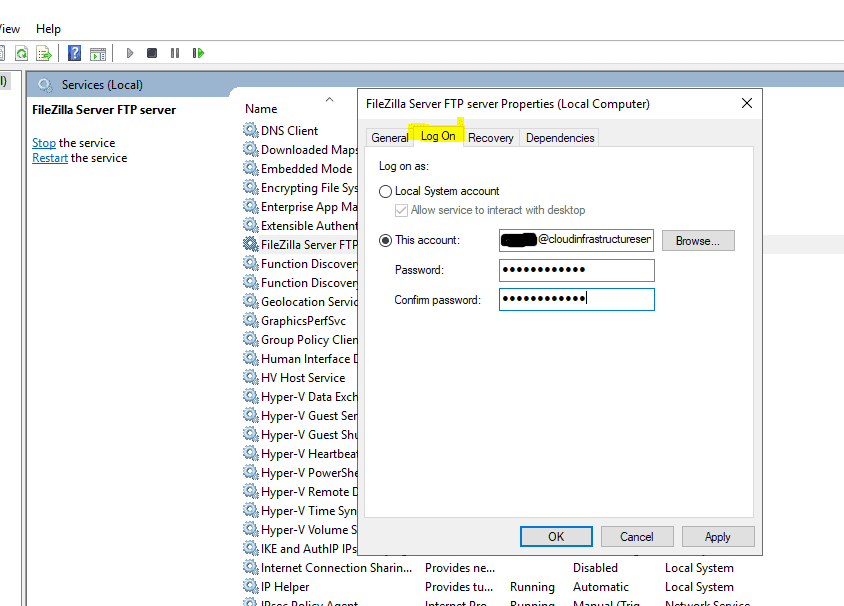

ACI service is very inexpensive and requires very little maintenance, while data is stored in Azure Files which is a fully managed SMB service in cloud. Creating a VM based SFTP is costly and high-maintenance.
#Windows azure ftp server how to#
There are additional instructions in the post for how to add the endpoints using powershell if you aren't aware of how to do so.SFTP is a very widely used protocol which many organizations use today for transferring files within their organization or across organizations. This will create the endpoint without a probe port (which was the portal behavior until recently). Remove the endpoints and then create them with Azure PowerShell using Add-AzureEndpoint, specifying only the name, protocol, localport and publicport parameters.

The 10.x.x.x address you see in the VM is the host server's IP address that the load balancer uses as the source IP to probe the port. As a result, the endpoint as unhealthy and stops sending traffic to the endpoint port. It is not open to the load balancer so the load balancer is unable to probe this port.
#Windows azure ftp server windows#
Port 60005 (for example) is likely only open in the Windows Firewall in the VM to those remote IPs that negotiated the passive mode ftp. Port 21 is open to all in Windows Firewall in the VM, so probe is successful, the endpoint is healthy and remote IPs can connect to it. The load balancer sends packets to the probe port to determine the health of the endpoint and if it does not get a response after a few retries, it will stop forwarding traffic to the endpoint port. Now by default it configures a probe port on the endpoint where the probe port is the same as the endpoint port. We believe this may have to do with a recent change to how the portal creates endpoints. I had a very similar issue recently that I was able to solve using the answer to this forum post (Credit goes to Craig Landis for the solution) So I tried to run an instance of Webmin and immediately tried to connect with my browser: it took a dozen of seconds to the daemon to start, but after started it looked like responding immediately, so that doesn't necessarily seem to be the cause The analysis above suggests me that there is a considerable delay between the accept() syscall done by the FTP server and the concrete possibility for Azure to route TCP SYN packets from public IP/port to private IP/port, thus causing timeout. How do I make vsftpd work again as expected? Please mind that I never changed configuration. I ran yast firewall but discovered that another firewall is active on the machine: I configured none of them! The strangely working-workaroundīy reducing the range of PASV ports to only one, I discovered that after a few attempts it eventually connects to the PASV port and displays directory listing The question I tried to check if firewall is disabled. Actually the process starts and is listed in netstat, but it takes a while for it to accept incoming connections from my client. When I start vsftpd from SSH console, it takes about a minute to go live. I also noticed another interesting thing. SYN packets from my IP never reach the server.But who the hell told that machine to connect to my FTP? 100.89.XXX.YYY, which is not part of any clusters of mine (it's not a cloud service I own but is in the same subnet as the virtual machine), gets lots of RST packets.I ran tcpdump on the server and discovered two things: STATUS:> Connecting to the server 'XXXXXXXXXXX'. STATUS:> Resolving the host 'XXXXXXXXXXXX'. Xftp client reports the following activity log: STATUS:> Session started. Further analyses conducted using tcpdump. When a client connects to FTP, it tries to enter Passive Mode but doesn't succeed. Port mappings (port 21 is on top of the listing, not shown in the screenshot) I have set them in my nf file and I have mapped all endpoints in Azure control panel. For passive FTP I chose ports 25003-25014 as range. I run FTP services on my virtual server with vsftpd. I had my machine not booting anymore so I recreated it fresh new from my disk image, which is supposed to work fine having worked fine so far. Recently, Windows Azure had a scheduled maintenance on Virtual Machine services.


 0 kommentar(er)
0 kommentar(er)
